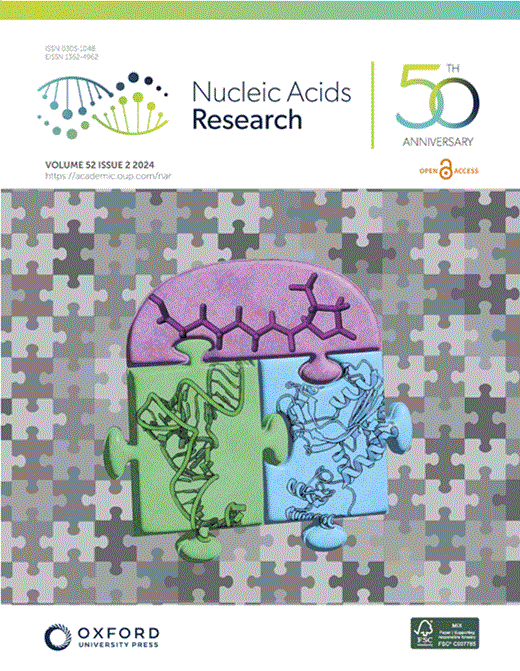挤压喷泉受到依赖于wapl的黏结物释放和CTCF屏障的限制
IF 16.6
2区 生物学
Q1 BIOCHEMISTRY & MOLECULAR BIOLOGY
引用次数: 0
摘要
间期染色体主要通过环挤压和区隔机制形成。然而,它们的时间成分和因果关系在很大程度上仍然未知。在这项研究中,我们利用小鼠胚胎干细胞中WAPL、CTCF和内聚蛋白的急性降解来研究环挤压的动力学及其与区隔化的关系。WAPL耗损对染色质上内聚蛋白的稳定作用导致延伸环的形成,并促进非收敛CTCF位点之间的环。WAPL的丧失也会导致区隔化的迅速减少,随后内聚蛋白的去除会逆转这种情况,直接表明挤压对区隔化的相反作用。利用WAPL和CTCF的联合耗竭,我们发现了喷泉,这是染色体组织的一个特征,来自增强子区域,并表现出很强的内聚结合。喷泉在有丝分裂后和哺乳动物发育早期迅速形成。内聚蛋白耗竭证实了喷泉依赖于内聚蛋白,它们的破坏导致喷泉近端基因的下调,这表明喷泉在基因调控中起作用。综上所述,通过利用急性蛋白质耗竭的时间精度,我们的研究揭示了喷泉作为挤压介导的3D基因组组织的快速形成特征。本文章由计算机程序翻译,如有差异,请以英文原文为准。
Extrusion fountains are restricted by WAPL-dependent cohesin release and CTCF barriers
Interphase chromosomes are mainly shaped by loop extrusion and compartmentalisation mechanisms. However, their temporal component and cause-effect relationships remain largely unknown. In this study, we use acute degradation of WAPL, CTCF and cohesin in mouse embryonic stem cells to investigate the dynamics of loop extrusion and its relationship to compartmentalisation. Stabilisation of cohesin on chromatin by depletion of WAPL results in the formation of extended loops and promotes looping between non-convergent CTCF sites. Loss of WAPL also results in a rapid decrease in compartmentalisation, which is reversed by subsequent removal of cohesin, directly demonstrating the opposite role of extrusion on compartmentalisation. Using combined depletion of WAPL and CTCF, we identify fountains, a feature of chromosome organisation that emanates from enhancer regions and exhibits strong cohesin binding. Fountains form rapidly after mitosis and early in mammalian development. Cohesin depletion confirms that fountains are cohesin dependent, and their disruption leads to the downregulation of fountain-proximal genes, suggesting a role in gene regulation. Taken together, by exploiting the temporal precision of acute protein depletion, our study reveals fountains as an extrusion-mediated, fast-forming feature of 3D genome organisation.
求助全文
通过发布文献求助,成功后即可免费获取论文全文。
去求助
来源期刊

Nucleic Acids Research
生物-生化与分子生物学
CiteScore
27.10
自引率
4.70%
发文量
1057
审稿时长
2 months
期刊介绍:
Nucleic Acids Research (NAR) is a scientific journal that publishes research on various aspects of nucleic acids and proteins involved in nucleic acid metabolism and interactions. It covers areas such as chemistry and synthetic biology, computational biology, gene regulation, chromatin and epigenetics, genome integrity, repair and replication, genomics, molecular biology, nucleic acid enzymes, RNA, and structural biology. The journal also includes a Survey and Summary section for brief reviews. Additionally, each year, the first issue is dedicated to biological databases, and an issue in July focuses on web-based software resources for the biological community. Nucleic Acids Research is indexed by several services including Abstracts on Hygiene and Communicable Diseases, Animal Breeding Abstracts, Agricultural Engineering Abstracts, Agbiotech News and Information, BIOSIS Previews, CAB Abstracts, and EMBASE.
 求助内容:
求助内容: 应助结果提醒方式:
应助结果提醒方式:


